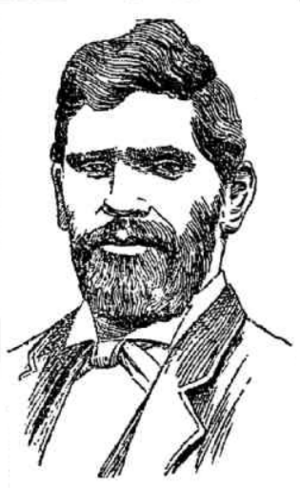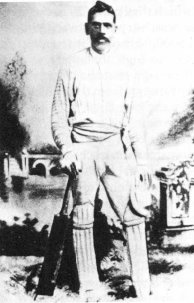Johnny Mullagh facts for kids
 |
|||||||||||||||||||||||||||
| Cricket information | |||||||||||||||||||||||||||
|---|---|---|---|---|---|---|---|---|---|---|---|---|---|---|---|---|---|---|---|---|---|---|---|---|---|---|---|
| Batting | Right-handed | ||||||||||||||||||||||||||
| Bowling | Right-arm | ||||||||||||||||||||||||||
| Career statistics | |||||||||||||||||||||||||||
|
|||||||||||||||||||||||||||
|
Source: CricInfo, 6 March 2018
|
|||||||||||||||||||||||||||
Johnny Mullagh (born Unaarrimin; 13 August 1841 – 14 August 1891) was an amazing Australian cricketer from Victoria. He was the top player on the famous 1868 Aboriginal cricket tour of England. He was a very skilled all-rounder, meaning he was great at both batting (hitting the ball) and bowling (throwing the ball). In December 2020, Mullagh was added to the Australian Cricket Hall of Fame, which is a huge honour!
Contents
Early Life and Cricket Beginnings
Johnny Mullagh was born Unaarrimin, a member of the Jardwadjali people. His birthplace was Mullagh Station, which is about 16 kilometres north of Harrow, Victoria. He was given the name "Mullagh" because of where he was born. He learned how to play cricket at the Edgars' Pine Hills farm in Harrow.
Mullagh's Cricket Skills
Mullagh played 47 matches during the 1868 tour of England. He scored 1698 runs, averaging about 20 runs per game. This was impressive because the cricket pitches were often difficult to play on.
He also bowled 1877 overs, with 831 of them being "maidens" (meaning no runs were scored off those overs). He took 245 wickets, which means he got 245 batters out. Sometimes, he even put on wicket-keeping gloves and managed to get four stumpings (a way to get a batter out).
During the 1800s, Indigenous peoples faced many challenges. The players on the England tour often had tough times after the tour ended. One player, named "King Cole," sadly passed away during the trip.
A historian named D. J. Mulvaney said that "Few contemporary cricketers better deserved the title of all-rounder" than Mullagh. His great performances led him to join the Melbourne Cricket Club (MCC) as a professional player in 1869–70. However, his time there ended early because he became very ill.
In 1870, Mullagh started playing for the Western District. He mostly played for Harrow after that. He had a unique way of hitting the ball, similar to a modern "ramp shot." He would drop to one knee and hold his bat over his shoulder. The ball would then fly high over the wicket-keeper's head for a boundary!
Mullagh was a very independent person. He also strongly supported Indigenous rights. He chose not to live on state-controlled reserves.
Even though he was a fantastic player, Mullagh never played in an inter-colonial cricket match (between different colonies). However, he did play for Victoria against a touring England team in 1879. He was 38 years old then and scored 36 runs in one innings, which was the highest score for his team.
Johnny Mullagh lived his final days in a small shack. He kept playing cricket until just a few months before he passed away in 1891. He died at Pine Hills Station, one day after his 50th birthday. The Hamilton Spectator newspaper called him "the [W.G.] Grace of aboriginal cricketers." Another writer said Mullagh was "Victoria's best batsman."
Mullagh's Lasting Impact
There is a special memorial built in Harrow to honour Johnny Mullagh. The local sports ground is even named Johnny Mullagh Oval. A cricket tournament for Indigenous teams has also been created, and the winning team receives the Johnny Mullagh Memorial Trophy.
In February 2012, the Premier of Victoria, Ted Baillieu, and the Minister for Aboriginal Affairs, Jeanette Powell, announced that Mullagh would be one of the first 20 people added to the Victorian Indigenous Honour Roll.
In December 2019, Cricket Australia announced a new award: the Johnny Mullagh Medal. This medal is given to the best player in the Boxing Day Test match each year, starting from 2020. On 29 December 2020, Indian cricketer Ajinkya Rahane was the first to receive this award. The next year, on 28 December 2021, another Aboriginal Australian, Scott Boland, won the medal after taking 7 wickets in his very first Test match!
See also
- Mullagh Medal
- List of Victoria first-class cricketers
- Twopenny – An Aboriginal Australian who played for New South Wales against Victoria in 1870.
- Jack Marsh – An Aboriginal Australian who played for New South Wales from 1900 to 1902.
- Albert Henry – An Aboriginal Australian who played for Queensland from 1902 to 1905.
- Eddie Gilbert – An Aboriginal Australian who played for Queensland from 1930 to 1936.


